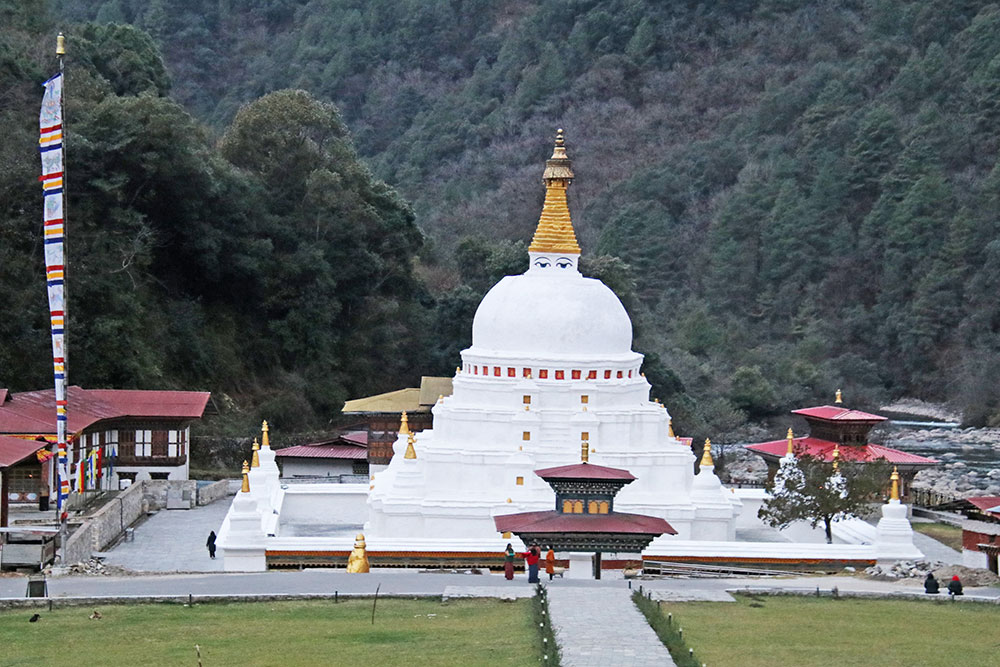Nima Wangdi | Tashiyangtse
The nearly-lost tradition of whitewashing the Choeten Kora stupa in Trashiyangtse, has been revived once again after almost 30 years.
With guidance from some village elders, a group of people took upon themselves to do it the traditional way.
From Langmola, they bring limestone, as the village elders used to in their days. Langmola is now just a few hours’ walk away from the Bumdeling farm road. Limestone is then burnt to extract lime (calcium carbonate). The process is long and tedious.

One of the organisers, Kencho Zangmo, who lives in Paro, said it was a difficult job. “This is the second year we are whitewashing the choeten in a tradition way.”
Kencho Zangmo and her friends once met in Thimphu and came up with the idea of whitewashing the choeten. “We had heard about how it was done in the past but never saw people do it. We wanted to revive that practice.”
Bumdeling gup, Mani Dorji, said he conducted research on extraction of limestone from Langmola and tried it. “It was a success and we could whitewash the choeten the traditional way successfully.”

The stones are burnt in large furnaces and crushed
“We will continue it for one more year to complete three years and then give the opportunity to other interested people,” he said.
The project is supported by financial donations from the people.
“I am planning to take the issue to the dzongkhag tshogdu and try to get a budget for it,” Mani Dorji said.
Kencho Wangmo said it was difficult to find limestone at the site and people carried the stones along precarious cliffs. “It is dangerous but nothing has happened as of now due to the blessing of the choeten.”
The hearth, where the limestone is burnt, is located in Nyangteng village. They also produce their own charcoal by burning wood. In the hearth, the stones and charcoal are arranged in layers. The stone is burnt until it is soft.
Dechen Tshering from Nyangteng is an expert. He said it is a difficult job. “I don’t get to sleep while the limestone is being burnt. It is tiring.”
The stone can be crushed with one’s fingers when it is ready and is left to cool down, after which it is taken to Choeten Kora where it is mixed with water. They stir the mixture until cream forms on the top.
“That’s what we apply on the choeten,” Dechen Tshering said.
They apply the residue of the lime first on the places where there are holes on the wall of the choeten. The cream of the lime is applied afterwards to give it a bright and sleek finishing.
Imported lime vs local lime
People say the local lime imparts a brighter shade to the choeten than the imported one. It also lasts longer.
Kencho Wangmo said that although the choeten was whitewashed once every two years in the past, they are going to whitewash it for three years continuously. “This is to plug or stuff the layers of lime on the choeten.”
History
Choeten Kora was under the care of Rigsum Gonpa Lama in Bumdeling, Trashiyangtse until it was handed over to the Zhung Dratshang some years ago. There were around 66 households (Lamai Drapa) under the control of Rigsum Gonpa Lama then. Whitewashing the choeten was the responsibility of Lamai Drapas.
Tharpala from Betsamang was a gomchen (lay monk) at Rigsum Gonpa. He has whitewashed the choeten many times.
“I am happy that the practice is revived once again today,” he said. “Towards the end of the 11th month of the Bhutanese calendar, the gomchens used to leave for Langmola to collect limestone. We used to recite prayers when we could not find enough limestone.”
Tharpala said the dome (bumpa) of the choeten used to look like an egg, white and smooth.
“We used to have a meal together after completing the work,” he said and the reflection of light from the freshly whitewashed choeten would brighten up the vicinity of the choeten.
Background
Chorten Cora is an important stupa constructed next to Khlongchu, close to Tashiyangtse town.
Lama Ngawang Lodroe, nephew of Zhabdrung Ngawang Namgyal, in order to subdue a harmful spirit, is believed to have constructed the choeten there. It was modelled after the famous Boudhanath Stupa (Jarung Khashor) in Nepal.
The choeten, built in 18th century, took 12 years to complete and was consecrated by Je Yonten Thaye.


